Research on Fault-Tolerant Field-Oriented Control of a Five-Phase Permanent Magnet Motor Based on Disturbance Adaption
Abstract
:1. Introduction
2. Five-Phase FTPMSM and Its FOC Strategy
3. Conventional SMOTC Strategy Based on Reduced-Order Transformation Matrices
3.1. Principle Analysis Reduced-Order Transformation Matrices
3.2. Problems Description
- (1)
- According to the traditional derivative calculation of the magnetic coenergy as regards the rotor position [23], and using (5)~(8) and the relationship between the back-EMFs and the flux linkages, the torque expression under the phase-A open-circuit fault condition can be obtained as:From (9), it can be noted that the torque ripples under the fault contain zero-sequence components, which is related to the zero-sequence current iz and rotor position θ. When an open-circuit fault occurs, to ensure a ripple-free torque operation, iz should be controlled to zero. Consequently, an additional control module is needed to be added, which is not conducive to the minimal reconfiguration of the drive system under fault-tolerant operation. In addition, the complexity of the algorithm is increased.
- (2)
- For the PM motors under fault conditions, the saturation effect and cross-coupling effect are more obvious. Therefore, with the influence of the fault, the amplitude of inductances and PM flux linkages may have some change and harmonics compared with that under normal conditions.To solve this issue, some research has been carried out. Robust design optimization can effectively improve the robustness of the variation of the amplitude of inductances and PM flux linkages [24], but this kind of scheme should be implemented in the motor design stage. In [13], the sliding mode control applied in the speed loop was proposed to suppress the torque ripple caused by the PM harmonic flux linkages. However, this scheme causes problems such as system oscillations and increased current harmonics. The online calculation and injection method of the third harmonic current were adopted after the fault [25], which could effectively restrain the torque ripple result from the third harmonic flux linkage of the rotor, but this control strategy needs multiple calculations of rotation transformation matrices to obtain the reference current values, which increases the complexity of the system implementation. Therefore, how to reduce or even eliminate the effect of changes in the amplitude of PM flux linkages on the operation performance of the system without increasing the complexity of the system remains to be overcome urgently.
- (3)
- A five-phase inverter is shown in Figure 3a, where N is the neutral point of the inverter, O is the midpoint of the capacitor, uiN (i = A,B,C,D,E) is the phase voltage, and uiO is the pole voltage. Usually, the inverter works by directly modulating the pole voltage. Nevertheless, in the case of an open-circuit fault, the phase voltage of the fault phase is modulated PWM thanks to the shift of the neutral point, which will affect the PWM modulation of the motor under the fault condition. In response to this problem, the existing literature generally adopts the back-EMFs compensation to weaken the influence of oscillating neutral, as shown in Figure 3b, but this scheme needs to add an additional back-EMFs compensation module, which is not beneficial to the minimal drive system reconfiguration under fault-tolerant operation.
- (4)
- The performance improvement under normal and fault-tolerant conditions is usually not considered at the same time. To achieve good fault-tolerant operating performance, the superior output performance of the motor drive system under normal operating conditions should be ensured. However, the vector control drive system based on the PI controller does not have good anti-interference performance against uncertain factors, such as load disturbance and motor parameter variation, which will have a great influence on the fault-tolerant operating performance.
4. FTC Strategy Based on Disturbance Adaption
4.1. Design of Current-Loop Steady-Healthy Controller
4.2. Design of the Enhanced Observer Analysis of The Stability
4.3. Modified Reduced-Order Coordinate Transformation Matrices
4.4. FTC Scheme
5. Verification Results
6. Conclusions
- (1)
- The speed-loop and current-loop steady-healthy controllers are constructed to provide good robust capacity to load disturbance, system parameter variation, and motor parameter variation under fault conditions. Apart from the high fault-tolerant capability, the proposed FTC provides favorable dynamic performances under fault conditions. Furthermore, because there is no need for the additional voltage compensation, the proposed FTC strategy is easily realized.
- (2)
- To eliminate the influence of oscillating neutral on the output performance at open-circuit fault, the modified reduced-order Clark inverse transformation matrix is designed by replacing the back-EMFs compensation in the traditional FTC algorithm. Hence, the minimal reconfiguration of the control drive system at fault-tolerant operation and the simple fault-tolerant algorithm can be achieved.
- (3)
- The proposed FTC strategy serves as a reference for the research that aims at the minimal drive system reconfiguration under faults and ensuring high-quality output torque both under normal and fault conditions.
Author Contributions
Funding
Institutional Review Board Statement
Informed Consent Statement
Data Availability Statement
Conflicts of Interest
References
- Hang, J.; Wu, H.; Ding, S.; Huang, Y.; Hua, W. Cost Function-Based Open-Phase Fault Diagnosis for PMSM Drive System with Model Predictive Current Control. IEEE Trans. Power Electron. 2021, 36, 2574–2583. [Google Scholar] [CrossRef]
- Huang, W.; Hua, W.; Chen, F.; Zhu, J. Enhanced Model Predictive Torque Control of Fault-Tolerant Five-Phase Permanent Magnet Synchronous Motor with Harmonic Restraint and Voltage Preselection. IEEE Trans. Ind. Electron. 2020, 67, 6259–6269. [Google Scholar] [CrossRef]
- Wang, H.; Zhao, W.; Tang, H.; Tao, T.; Saeed, S. Improved Fault-Tolerant Model Predictive Torque Control of Five-Phase PMSM by Using Deadbeat Solution. IEEE Trans. Energy Convers. 2022, 37, 210–219. [Google Scholar] [CrossRef]
- Song, Z.; Zhou, F.; Yu, Y.; Zhang, R.; Hu, S. Open-Phase Fault-Tolerant Predictive Control Strategy for Open-End-Winding Permanent Magnet Synchronous Machines without Postfault Controller Reconfiguration. IEEE Trans. Ind. Electron. 2021, 68, 3770–3781. [Google Scholar] [CrossRef]
- Zhou, H.; Xu, J.; Chen, C.; Tian, X.; Liu, G. Disturbance-Observer-Based Direct Torque Control of Five-Phase Permanent Magnet Motor under Open-Circuit and Short-Circuit Faults. IEEE Trans. Ind. Electron. 2021, 68, 11907–11917. [Google Scholar] [CrossRef]
- Saeed, M.S.R.; Song, W.; Yu, B.; Wu, X. Low-Complexity Deadbeat Model Predictive Current Control with Duty Ratio for Five-Phase PMSM Drives. IEEE Trans. Power Electron. 2020, 35, 12085–12099. [Google Scholar] [CrossRef]
- Zhang, L.; Zhu, X.Y.; Cui, R.H.; Han, S. A Generalized Open-Circuit Fault-Tolerant Control Strategy for FOC and DTC of Five-Phase Fault-Tolerant Permanent-Magnet Motor. IEEE Trans. Ind. Electron. 2022, 69, 7825–7836. [Google Scholar] [CrossRef]
- Sen, B.; Wang, J. Stationary Frame Fault-Tolerant Current Control of Polyphase Permanent-Magnet Machines under Open-Circuit and Short-Circuit Faults. IEEE Trans. Power Electron. 2016, 31, 4684–4696. [Google Scholar]
- Chen, Q.; Gu, L.; Lin, Z.; Liu, G. Extension of Space-Vector-Signal-Injection-Based MTPA Control into SVPWM Fault-Tolerant Operation for Five-Phase IPMSM. IEEE Trans. Ind. Electron. 2020, 67, 7321–7333. [Google Scholar] [CrossRef]
- Xiong, C.; Guan, T.; Zhou, P.; Xu, H. A Fault-Tolerant FOC Strategy for Five-Phase SPMSM with Minimum Torque Ripples in the Full Torque Operation Range under Double-Phase Open-Circuit Fault. IEEE Trans. Ind. Electron. 2020, 67, 9059–9072. [Google Scholar] [CrossRef]
- Guzman, H.; Duran, M.J.; Barrero, F.; Zarri, L.; Bogado, B.; Prieto, I.G.; Arahal, M.R. Comparative Study of Predictive and Resonant Controllers in Fault-Tolerant Five-Phase Induction Motor Drives. IEEE Trans. Ind. Electron. 2016, 63, 606–617. [Google Scholar] [CrossRef]
- Zhou, H.; Zhao, W.; Liu, G.; Cheng, R.; Xie, Y. Remedial Field-Oriented Control of Five-Phase Fault-Tolerant Permanent-Magnet Motor by Using Reduced-Order Transformation Matrices. IEEE Trans. Ind. Electron. 2017, 64, 169–178. [Google Scholar] [CrossRef]
- Tian, B.; An, Q.; Duan, J.; Sun, D.; Sun, L.; Semenov, D. Decoupled Modeling and Nonlinear Speed Control for Five-Phase PM Motor under Single-Phase Open Fault. IEEE Trans. Power Electron. 2017, 32, 5473–5486. [Google Scholar] [CrossRef]
- Tian, B.; Mirzaeva, G.; An, Q.; Sun, L.; Semenov, D. Fault-Tolerant Control of a Five-Phase Permanent Magnet Synchronous Motor for Industry Applications. IEEE Trans. Ind. Appl. 2018, 54, 3943–3952. [Google Scholar] [CrossRef]
- Zhang, L.; Fan, Y.; Cui, R.H.; Lorenz, R.D.; Cheng, M. Fault-Tolerant Direct Torque Control of Fve-Phase FTFSCW-IPM Motor Based on Analogous Three-Phase SVPWM for Electric Vehicle Applications. IEEE Trans. Veh. Technol. 2018, 67, 910–919. [Google Scholar] [CrossRef]
- Tian, B.; Sun, L.; Molinas, M.; An, Q.T. Repetitive Control Based Phase Voltage Modulation Amendment for FOC-Based Five-Phase PMSMs under Single-Phase Open Fault. IEEE Trans. Ind. Electron. 2021, 68, 1949–1960. [Google Scholar] [CrossRef]
- Tian, B.; Molinas, M.; An, Q. PWM Investigation of a Field-Oriented Controlled Five-Phase PMSM under Two-Phase Open Faults. IEEE Trans. Energy Convers. 2021, 36, 580–593. [Google Scholar] [CrossRef]
- Parsa, L.; Toliyat, H.A. Fault-Tolerant Interior-Permanent-Magnet Machines for Hybrid Electric Vehicle Applications. IEEE Trans. Veh. Technol. 2007, 56, 1546–1552. [Google Scholar] [CrossRef]
- Barrero, F.; Bermudez, M.; Duran, M.J. Assessment of a Universal Reconfiguration-Less Control Approach in Open-Phase Fault Operation for Multiphase Drives. Energies 2019, 12, 4698. [Google Scholar] [CrossRef] [Green Version]
- González-Prieto, I.; Durán, M.J.; Bermúdez, M.; Barrero, F.; Martín, C. Assessment of Virtual-Voltage-Based Model Predictive Controllers in Six-Phase Drives under Open-Phase Faults. IEEE J. Emerg. Selec. Top. Power Electron. 2020, 8, 2634–2644. [Google Scholar] [CrossRef]
- Zhang, L.; Fan, Y.; Lorenz, R.D.; Nied, A.; Cheng, M. Design and Comparison of Three-Phase and Five-Phase FTFSCW-IPM Motor Open-End Winding Drive Systems for Electric Vehicles Applications. IEEE Trans. Veh. Technol. 2018, 67, 385–396. [Google Scholar] [CrossRef]
- Zhang, L.; Zhu, X.Y.; Gao, J.; Mao, Y. Design and Analysis of New Five-Phase Flux-Intensifying Fault-Tolerant Interi-Or-Permanent-Magnet Motor for Sensorless Operation. IEEE Trans. Ind. Electron. 2020, 67, 6055–6065. [Google Scholar] [CrossRef]
- Gaeta, A.; Scelba, G.; Consoli, A. Modeling and Control of Three-Phase PMSMs under Open-Phase Fault. IEEE Trans. Ind. Appl. 2013, 49, 74–83. [Google Scholar] [CrossRef]
- Tamás, O.; Anton, R.; Ants, K.; Pedro, A.; David, P.; Jan, K.; Pavel, K. Robust Design Optimization and Emerging Technologies for Electrical Machines: Challenges and Open Problems. Appl. Sci. 2020, 10, 6653. [Google Scholar]
- Liu, G.; Lin, Z.; Zhao, W.; Chen, Q.; Xu, G. Third Harmonic Current Injection in Fault-Tolerant Five-Phase Permanent-Magnet Motor Drive. IEEE Trans. Power Electron. 2018, 33, 6970–6979. [Google Scholar] [CrossRef]
- Zhang, L.; Zhu, X.Y.; Xu, L.; Zhang, C.; Fan, Y. Simplified Universal Fault-Tolerant Direct Torque Control of FPFTPM Motor with Steady-Healthy Design under Open-Circuit Fault. IEEE Trans. Ind. Electron. 2022, 69, 6688–6699. [Google Scholar] [CrossRef]
- Xu, J.; Du, Y.; Zhang, B.; Fang, H.; Guo, H.; Chen, Y.H. Sensorless Fault Tolerant Control with Phase Delay Compensation for Aerospace FTPMSM Drives with Phase Open-Circuit and Short-Circuit Faults. IEEE Trans. Ind. Electron. 2021, 68, 4576–4585. [Google Scholar] [CrossRef]
- Chen, Y.H. On the Deterministic Performance of Uncertain Dynamical Systems. Int. J. Control 1986, 43, 1557–1579. [Google Scholar] [CrossRef]
- Zhou, H.; Zhou, C.; Tao, W.; Wang, J.; Liu, G. Virtual-Stator-Flux-Based Direct Torque Control of Five-Phase Fault-Tolerant Permanent-Magnet Motor with Open-Circuit Fault. IEEE Trans. Power Electron. 2020, 35, 5007–5017. [Google Scholar] [CrossRef]

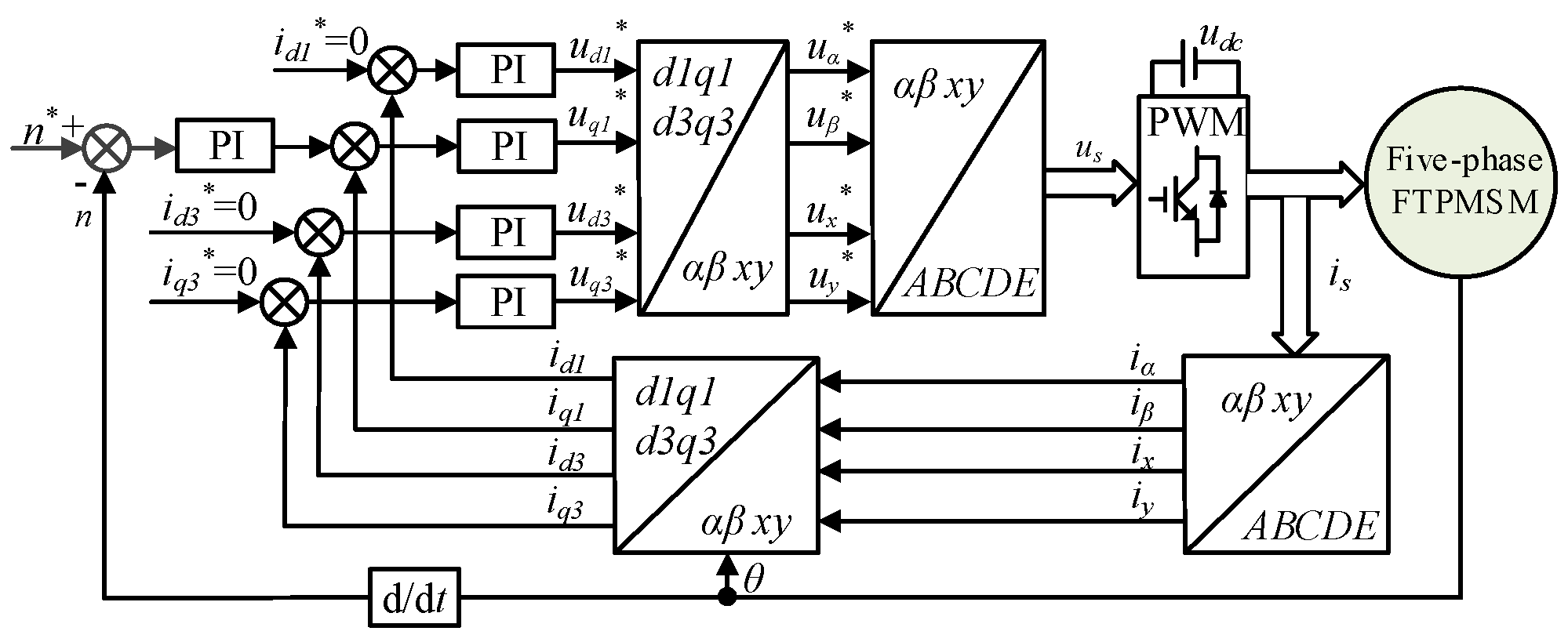


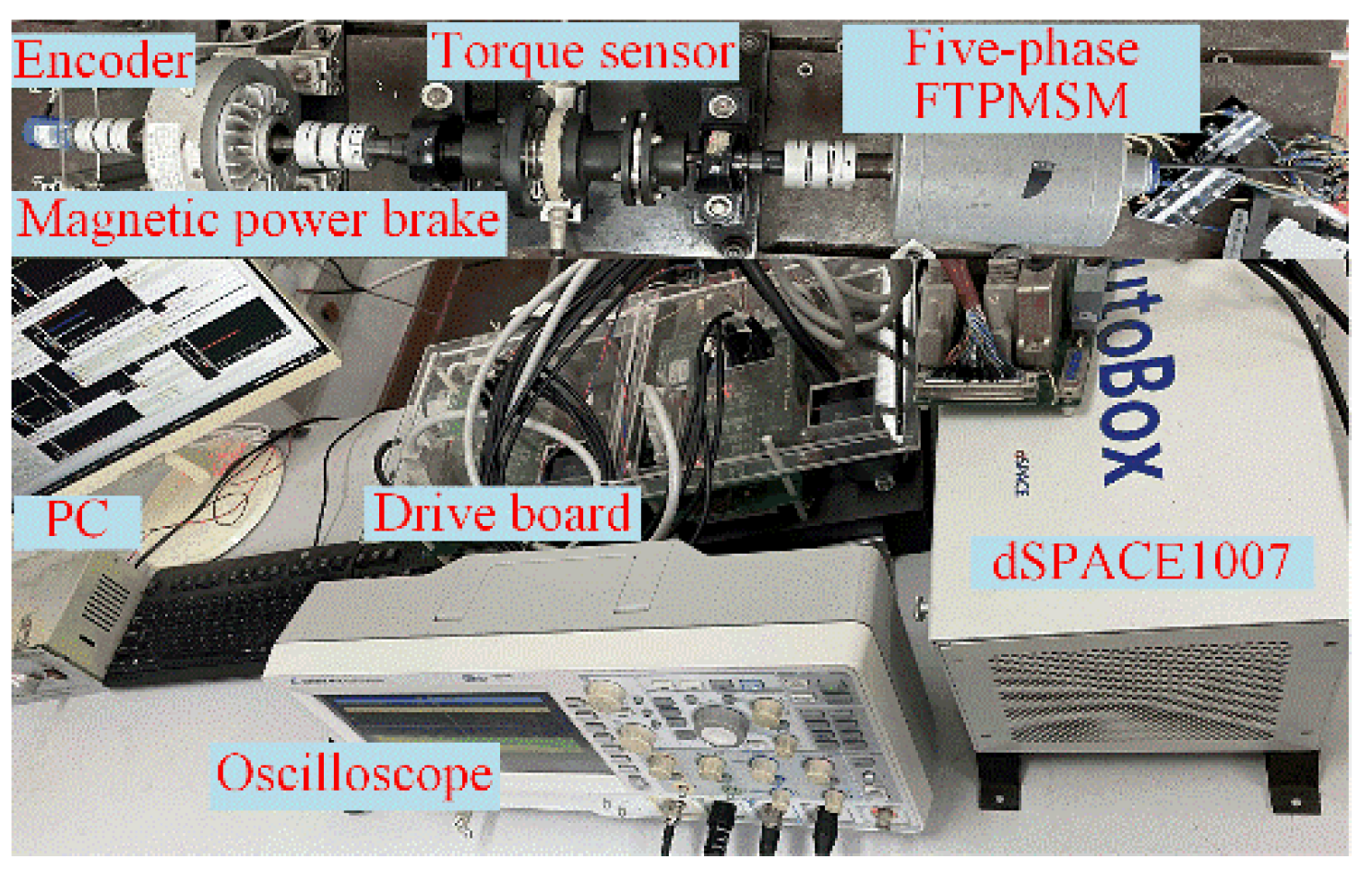

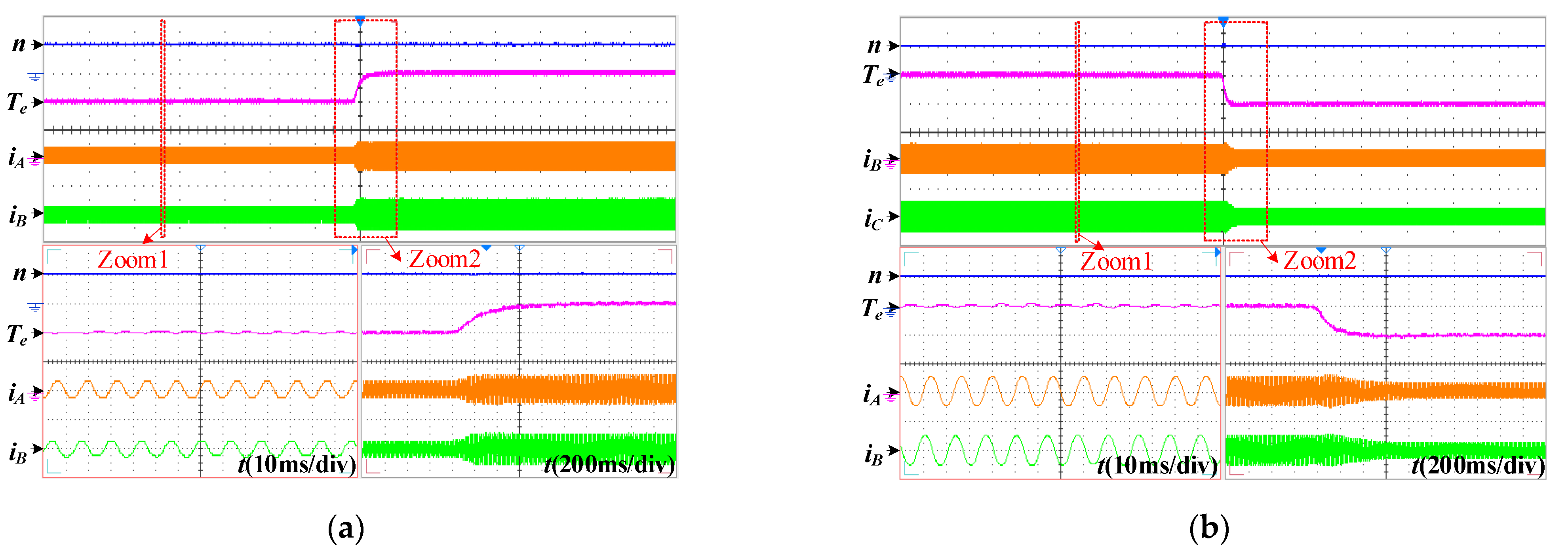

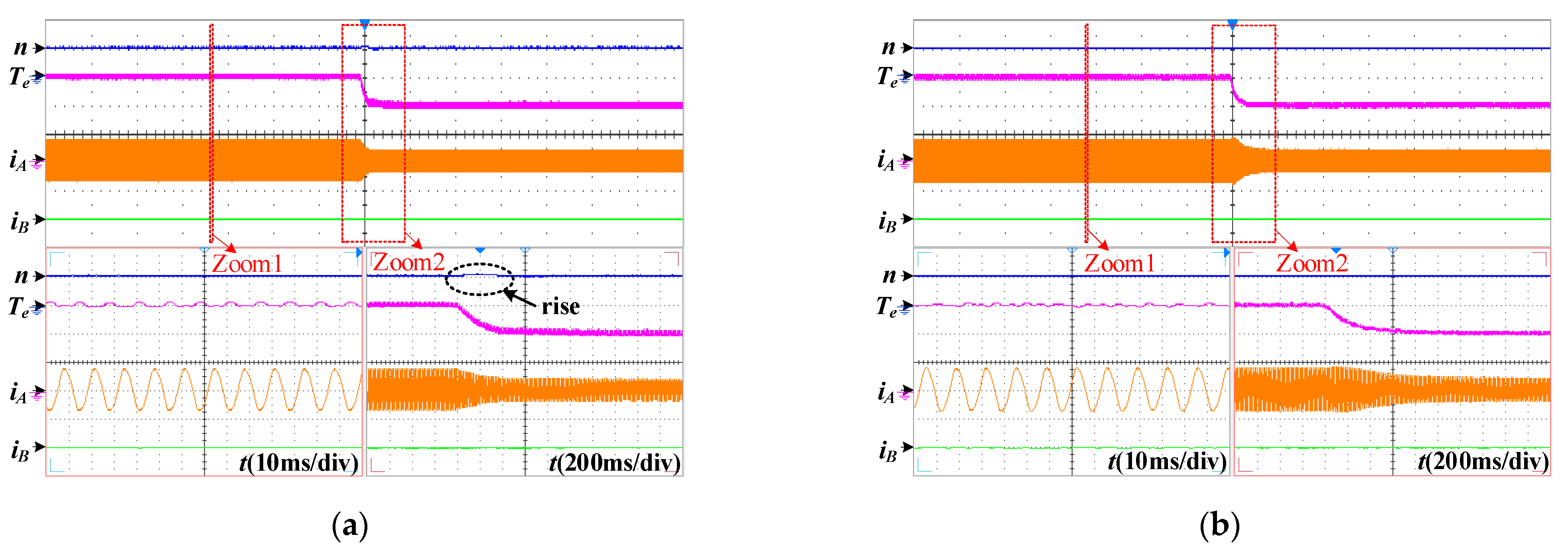
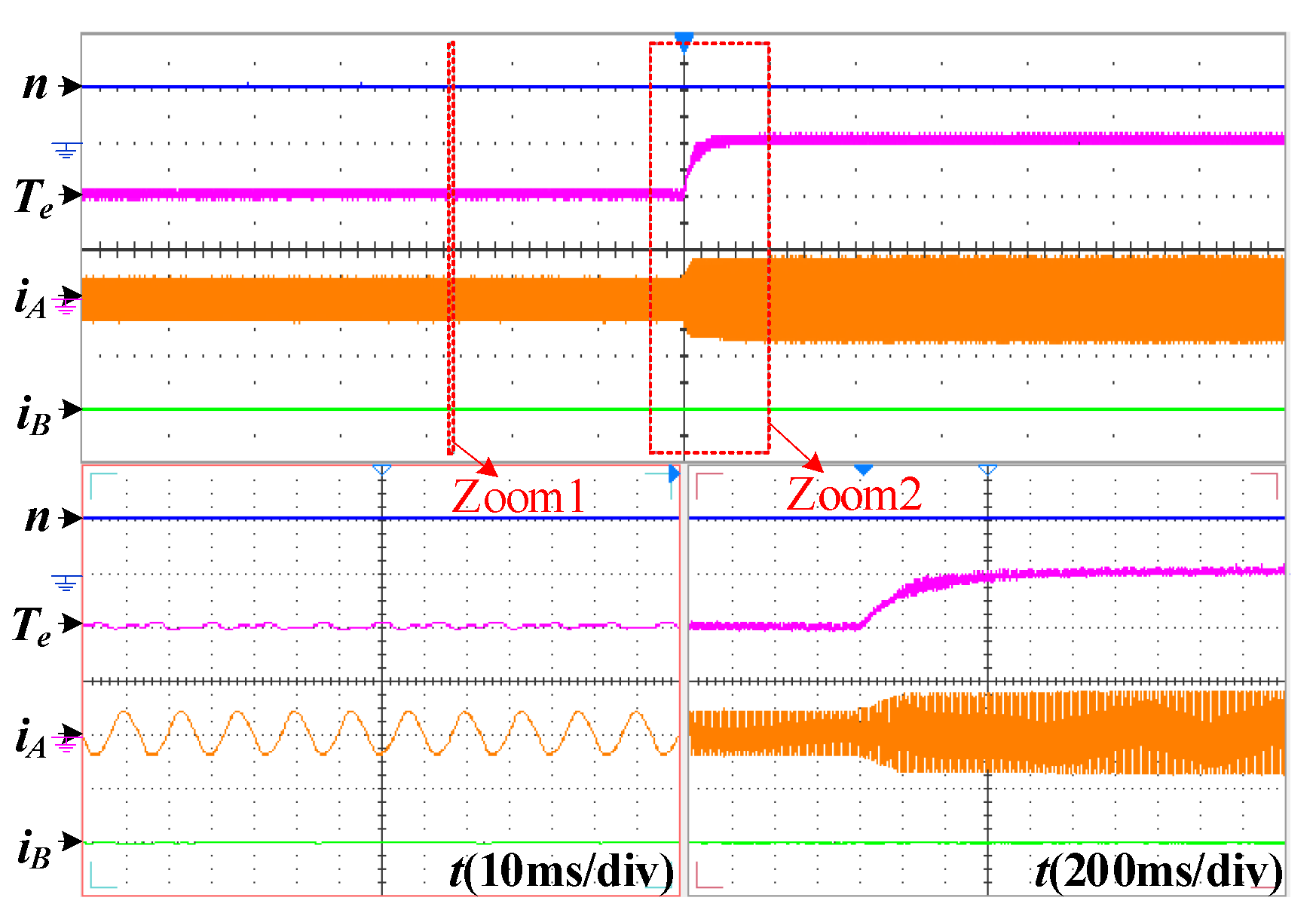
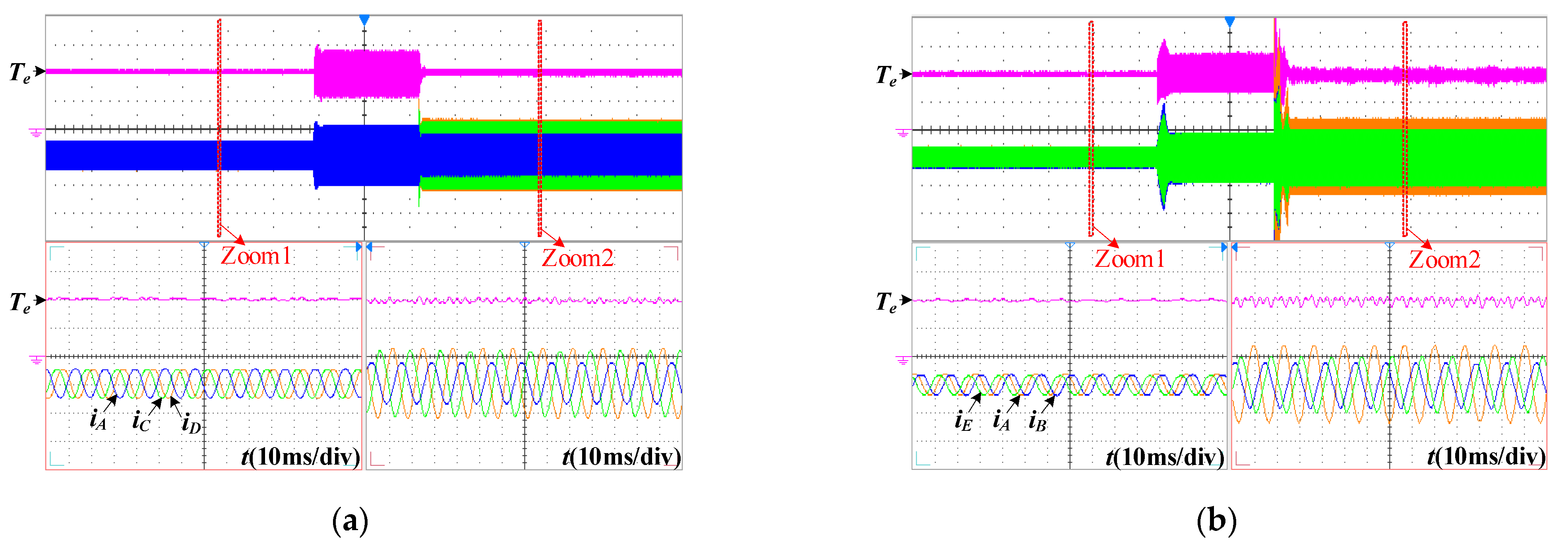
| Parameter | Value | Parameter | Value |
|---|---|---|---|
| Rated power | 2 kW | PM flux-linkage | 0.089 Wb |
| Rated phase current | 4.75 A | Stator resistance | 0.5 Ω |
| Number of rotor pole-pair | 9 | d-axis inductance | 13.5 mH |
| Number of stator slot | 20 | q-axis inductance | 14.7 mH |
Publisher’s Note: MDPI stays neutral with regard to jurisdictional claims in published maps and institutional affiliations. |
© 2022 by the authors. Licensee MDPI, Basel, Switzerland. This article is an open access article distributed under the terms and conditions of the Creative Commons Attribution (CC BY) license (https://creativecommons.org/licenses/by/4.0/).
Share and Cite
Zhang, L.; Dong, C.; Wang, Y.; Han, S. Research on Fault-Tolerant Field-Oriented Control of a Five-Phase Permanent Magnet Motor Based on Disturbance Adaption. Energies 2022, 15, 3436. https://doi.org/10.3390/en15093436
Zhang L, Dong C, Wang Y, Han S. Research on Fault-Tolerant Field-Oriented Control of a Five-Phase Permanent Magnet Motor Based on Disturbance Adaption. Energies. 2022; 15(9):3436. https://doi.org/10.3390/en15093436
Chicago/Turabian StyleZhang, Li, Chenyang Dong, Yucheng Wang, and Sai Han. 2022. "Research on Fault-Tolerant Field-Oriented Control of a Five-Phase Permanent Magnet Motor Based on Disturbance Adaption" Energies 15, no. 9: 3436. https://doi.org/10.3390/en15093436
APA StyleZhang, L., Dong, C., Wang, Y., & Han, S. (2022). Research on Fault-Tolerant Field-Oriented Control of a Five-Phase Permanent Magnet Motor Based on Disturbance Adaption. Energies, 15(9), 3436. https://doi.org/10.3390/en15093436






